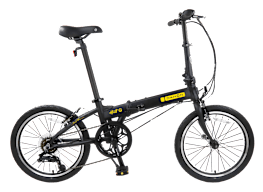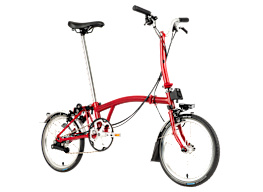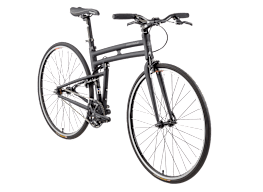How to Shop for a Bike for Your Kid
From ages 8 to 12, kids grow fast and learn fast, so picking the right ride isn't a matter of just future-proofing

The school-age and preteen years can be a confusing time for parents when it comes to choosing a bicycle for a child. Not only are kids that age growing fast—typically, a 50th-percentile boy gains about 8 inches from ages 8 to 12, while 50th-percentile girls grow almost exactly the same amount, from about 50 to 58 inches—but their riding skills can vary wildly from year to year or from kid to kid. So if you brought your son or daughter’s bike out from winter hibernation only to find that they now look like a circus bear on a tiny tricycle as they ride, your kid may be due for an upgrade.
Then again, you may be tempted to jump one or two bike sizes in the interest of future-proofing your purchase for your fast-growing spawn. Margarita Rypkowski, the manager at Oro Valley Bicycle in Tucson, Ariz., says “that’s going to make them miserable” because, Rypkowski says, a too-tall, too-rangy bike is hard to control even for an adult. She says you could end up with a machine that’s cumbersome and potentially even dangerous for your child to ride. And that’s not going to be any fun.
Get Thee to a Bike Shop
You may end up shopping a variety of retailers online, or hunting for a deal on a used bike on Facebook Marketplace or Craigslist, but your first stop should be a local bike shop. Be honest and up front with the bike pro. Let them know that you plan to shop around but that you want some help finding the right size bike for your child—and wherever you end up buying, you’ll be back to get the bike fitted. That latter visit may be gratis; the bike might fit your child perfectly. Or you may need a few parts swapped to make it fit better. Those parts could run you anywhere from $20 to $100, entirely depending on what you need. A different stem or bar ranges from $20 to $50; a different saddle might cost you about $25. Rypkowski, the store manager of Oro Valley Bicycle, says that every decent bike shop knows the drill and that you should understand that most shops make their money from repairs, not the actual bike sale, so doing a bare-bones fitting is just smart for a shop to do either free or for a very nominal cost. “We just want to put that kid on a bike that fits,” she says.
That initial assessment should just be to capture what’s called standover. That’s the child’s inseam, from their groin to the floor while flat-footed, in shoes, standing directly over the bike frame (not seated on the bike saddle) while the bike is stationary, to be sure there’s clearance between their body and the frame. This, Rypkowski says, is critical for both safety and comfort, and it’s why buying a too-big bike is a recipe for scariness and danger. “Your kid has to feel safe and comfy on the bike,” she says. “That’s the only way for them to like it and to enjoy riding.”


And a bike shop is the perfect place to do this: A pro there can measure your child’s stance over a variety of bike sizes. The bike industry roughly ballparks bikes by wheel size, where bikes with 16-inch-diameter wheels are for 4- to 6-year-olds, 20-inchers are for 6- to 8-year-olds, and 24-inch-wheeled bikes are for children between 8 and 10. If we’re talking about a kid who’s already about 5 feet tall or just shy of that, a lot of adult bikes with 26- or even 27.5-inch wheels could fit. According to Rypkowski, however, the age guidance might not apply to your child. “Is your kid the smallest or the tallest in their class?” she asks. In other words, don’t worry about the wheel size as much as that standover clearance. (Note, too, that if your kid clears that frame by 4 or 5 inches, the bike they’re riding currently is too small.)
Why You Should Avoid the Cheapest Bikes
All the experts we consulted cautioned against buying the cheapest bikes you could find at a big-box store. That’s because many of the mass-market discount bikes are of dubious quality, and the parts aren’t always easily adjustable. That matters because after that initial fitting with your child at a bike shop, you’ll want that store to refine all the touch points when you purchase a bike.
Those changes can include the reach to the bars, swapping out the saddle for one with a better fit, both width- and lengthwise, as well as adjusting seat height, and possibly the brakes and shifting components—all of which matter to the comfortable and safe operation of the bike. A cheap bike that doesn’t have common or adjustable parts will make it difficult, if not impossible, to change or swap these parts. So even if you chance into a bike that works for your kid right now, it won’t be able to grow with your child, and you’ll end up shopping for another one within a year or so.
A high-quality new bike will cost you $400 to $600. That is the rough range of a new kid’s bike that’s adjustable and lighter weight. But a good bike can also return at least part of its value on the resale market. Justin England is the director of business development at the Pro’s Closet, an online retailer that buys and resells bikes. He says big-box store bikes have “zero resale market. They go straight into a dumpster once your kid outgrows them.” But the flipside is that England says his company does resell bikes from well-known, reputable makers, such as Giant, Specialized, Woom, Cannondale, and Trek. England adds that a decent bike for a child will last through generations of kids because “you’ll sell it to a friend or resell it on Craigslist. That also means that it’s a sustainable product, as well as giving you a return on investment.”
That also means that you can save even more money by shopping the used market (more on that below), where a typical high-quality bike can go for $250 to $450.
Don't Forget a Bike Helmet.
Check out CR’s bike helmet ratings and buying guide.
How to Shop for a Bike
Buying From a Walk-In Bike Shop
Retailers are a lot like car dealerships, meaning they sell specific brands but still largely make their living on maintenance and repairs as well as service.
Upsides: The advantage to buying this way is that you’re creating a relationship with the folks there. And because your kid is going to grow, you know you want that relationship anyway, because you’re going to be back when (not if) your kid gets a flat tire and when (not if) your child’s bike needs to be adjusted to fit them as they grow. Also, a bike dealer knows their product inside and out, and will be able to order parts for that bike easily. So the experience is just more streamlined than any other kind of purchasing process. England, from the Pro’s Closet, says that because the supply chain for bikes is so tight, a lot of shops these days also sell and refurbish used bikes, and will offer you at least a store credit, if not actual cash, when you inevitably need to trade up to the next-sized bike as your child outgrows their current one.
Downsides: Obviously, buying anything new costs more. You’re paying for a smoother experience. But you’re also paying for lessening possible frustrations from the alternative purchasing paths.
Buying New Online
There are a few startup brands that make bikes just for kids and only have an internet presence, or direct to consumer (DTC). The outdoor retailer REI has walk-in stores or will arrange to ship a bike directly to you, and it has its own line of bikes for adults and kids called Co-op Cycles. England at the Pro’s Closet says REI’s bikes are well-built and well-designed, and he also loves a brand called Woom. A few parents we talked to for this reporting also praised Woom, a DTC bike maker that focuses solely on bikes for children. Another brand in this vein is Guardian Bikes, a slightly less pricey Woom competitor.
Upsides: One obvious advantage to web-based DTC purchasing is that you’re shopping directly with the brand in question, not going through the local dealer, which is suffering supply shortages and, in most cases, beholden to carrying only a few brands. DTC opens you to a much wider purchasing field, and especially if you don’t live in an area with a lot of bike shops, it might be your only option for getting a bike now, not in six months.
Downsides: Brands like REI and Woom have video resources for assembly of their products, but you still have to own some tools and feel reasonably confident about what you’re doing. And while bike shops are likely to do a gratis initial fit of your kid, they would charge for assembly of a bike you purchased online. (They won’t charge for that if you buy a bike directly from them.) So it’s possible that any money you save buying DTC will evaporate if you plan to have the bike built at the local shop.
Buying Used Online—or From Your Neighbor
Buying a used bike could save you a few hundred dollars.
Upsides: Shopping the used market on platforms such as Facebook Marketplace, eBay, and Craigslist opens you up to a lot of options, and you’re likely to save a few hundred bucks, too. But going this route requires some research and diligence.
Beware of anyone unloading a cheap, big-box bike on the secondhand market. You won’t really save a lot of money, and you’ll just be inheriting a used version of all the fit and reliability issues we mentioned above. Justin England of the Pro’s Closet suggests that a bit of poking around online, keeping an eye out for brands you know and trust, will give you a baseline of fair market pricing.
Going with a more full-service retailer like England’s shop can make the process a bit smoother. The Pro’s Closet sells used bikes and ships them directly to you, with the advantage of vetting and prepping the bike for you to assemble.
Downsides: Getting ripped off isn’t unusual in the online marketplace. Your recourse with these transactions is frequently weak or, at best, time-consuming. You’re at the mercy of the seller even knowing the bike size they’re listing. For this reason, we advise going for a local purchase through Facebook Marketplace or Craigslist, so at least you can take your child to go see the bike in person to make sure it’s going to fit.
Refine the Fit for Your Child’s Comfort and Safety
Regardless of where you purchase your kid’s bike, it’s critical to adjust it for a proper fit. If you’re skilled with wrenches and have a deep understanding of bike parts and human anthropometry, you can try this yourself—but for the most comfortable fit and safest results, you’re probably better off entrusting the process to a good bike shop.
As we mentioned above, the bike might fit your child perfectly. Or if you’re buying used, perhaps you want to change a saddle or other parts that are worn out, or further refine the fit for safety and comfort. This means budgeting a few extra dollars to be sure your kid is put in the best position for success—and fun!—though that cost could also be considerably lower if your kid happens to already fit the bike well. Here are the most important adjustments to consider.
Seat Height
The seatpost is a tube of metal that telescopes up and down in the frame to adjust the seat to the proper height for pedaling. Proper seat height allows your child’s knees to have a slight bend at full extension. If their stroke is too short, they’re getting less power out of every revolution. And if they’re sitting too low, that can mean their knees will rise higher than is comfortable.
One caveat: Oro Valley Bicycle’s Rypkowski says that for newer or less confident riders, your child might not be ready for the proper seat height, because sliding off the seat to stand flat-footed could be a big jump for them. Her advice for these kids is to start with a lower saddle and just adjust it up a little bit at a time as your child gains confidence. This is easy to do, by the way. Take a permanent marker and create a line on the seatpost for a reference point. Open the quick-release lever (that uses friction to hold the post in place) and slide the seatpost up just a hair; be sure the seat is directly aligned straight, with the nose of the saddle directly over the top tube of the frame, then close the quick release.
Swap That Seat
Burton Avery is Cannondale’s category manager for kids. He says that just like for adults, “the No. 1 thing that you should consider changing when anyone buys a bike is the saddle.” The best analogy: shoes. You have to try them on to know they fit, no matter if you’re a child or an adult. Specialized, Woom, and Cannondale all spec far narrower and shorter saddles for kids than you’ll find on adult bikes.
One telltale sign that your kid’s seat is too wide is if you see them inching far forward on the seat, riding the nose rather than the paddle portion. That could mean they just have too far to reach the handlebars, or it could mean the seat’s too wide, which hurts their bottom and also forces their legs to splay wider while pedaling, which will cause knee pain.
Reach
The bike you buy will come with a stem (the linkage between the front of the frame and the handlebars) that’s replaceable, so you can make that shorter if your child has to reach too far or longer so that the reach isn’t cramped as your kid grows. A stem has an adjustable clamp for the handlebars, which must also be replaceable, because the right width and sweep can further help your kid get comfy.
Brakes and Shifters
There are two main types of brakes found on children’s bikes: coaster brakes and hand brakes, although some bikes have both. Part of this is regulatory and beyond the control of manufacturers; they may have to spec a coaster brake because there are legacy laws governing how bikes are sold.
Coaster brakes work by pedaling backward. Lots of bikes for smaller children have them.
Hand brakes operate via a lever attached to the handlebar, and most bikes for children only brake the rear wheel. There are two types of hand brakes as well. Disc brakes tend to have more power and are a bit more expensive, and work better in all kinds of weather; rim brakes clamp against the wheel’s rim and may be less potent, though frequently offer at least the same level of modulation as a disc brake.
If your child’s bike has lever-actuated brakes, those levers most likely have a reach adjustment. This brings the lever closer to the handlebar, so it’s easier for smaller hands to grab, which is critical for safety. If the bike you purchased doesn’t have this adjustment, a bike shop can swap out the levers for adjustable ones.
As with brakes, your child needs to be able to easily operate their shifters. Avery at Cannondale says bike makers are increasingly building bikes with low-effort shifters, meaning the mechanism isn’t as stiff as in adult bikes. Raul Atencio, the retail manager at Universal Cycles in Portland, Ore., says you want to hold a bike statically and watch to see whether your child can easily operate the brake levers and shifters. Again, the local shop should make this evaluation. Know that, like brake reach adjustment, shifters can also be repositioned for better leverage for your kid to use.
Tires
Knobby tires might look cool, but they add friction. Cannondale’s Avery says that his brand has gone to either a tire with a very low knob pattern, with fewer cuts (called sipes), or to one with no tread pattern at all, because this reduces rolling resistance, so it’s easier for a child to keep up with their parents. He says if you find a used bike for your child that has a tall knob, take it to a bike shop and swap the tires for something that rolls more quickly.
Weight
A general rule of thumb for kid’s bikes is that ideally the machine doesn’t tilt the scales at more than a third to about half of your child’s weight. The younger your kid is, the harder it will be to find a bike that’s light enough, but this is also why our guidance is that you avoid the cheapest bikes from big-box stores, because those bikes tend to be especially heavy. Raul Atencio, the retail manager at Universal Cycles, says that you don’t need to take his word for it. “Just go in there and try to lift one!” He says they’re generally just far too heavy for your kid to want to pedal. High-quality bike manufacturers tend to list their bike weights on their sites (see box below). However, it is more challenging to find accurate bike weight listings for older products. Still, one tip there is to try to avoid kids bikes with suspension forks or rear shocks. These look cool but add complexity and weight.
Sizes and Weights of Common Kids' Bikes
| Brand | Model | Weight |
| Cannondale | Kids Quick 20” | 19.2 lb. |
| Cannondale | Kids Quick 24” | 20.7 lb. |
| Specialized | Jett 20” MS | 19.3 lb. |
| Specialized | Jett 24” | 20.5 lb. |
| Woom | OFF 4 20” | 17.2 lb. |
| Woom | OFF 5 24” | 18.9 lb. |
Correction: A previous version of this article stated that the bicycle manufacturer Woom sold its products both direct to consumer as well as in stores. It sells only direct to consumer in the United States. This article was first published on April 18, 2022.






















